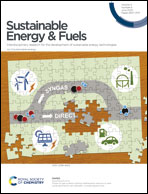Near-infrared-driven water splitting for hydrogen evolution using a Cu2ZnSnS4-based photocathode by the application of upconversion nanoparticles†
Abstract
In recent years, photoelectrochemical (PEC) water splitting has become an attractive approach for the production of renewable hydrogen by utilizing solar energy. Achieving high-efficiency hydrogen production via solar water splitting requires a semiconductor with a suitable band gap. Generally, a wide band gap results in an ideal open-circuit voltage for solar water splitting devices, but it makes the devices incapable of absorbing and utilizing the near-infrared (NIR) portion of sunlight. To further improve the utilization efficiency for solar energy, we employ rationally designed core–shell or core–shell–shell structured upconversion nanoparticles (UCNPs) as “nanotransducers” that enable the conversion of NIR light into visible light; thus, NIR light can be indirectly absorbed by visible light-responsive photocathodes. Upon doping with different lanthanides, our prepared UCNPs gain the ability to convert NIR light (980 nm) into blue, green, or red light. Although the Cu2ZnSnS4 (CZTS) photocathode shows an excellent response to visible light, it is almost unable to absorb NIR light beyond 860 nm. After addition of UCNPs into the buffer solution, the CZTS-based photocathode exhibits an appreciable photocurrent density of −4 mA cm−2 at 0 VRHE under 980 nm irradiation. This work demonstrates that the solar-to-hydrogen conversion efficiency of the photoelectrode can be further boosted with the involvement of UCNPs as a NIR energy converter.



 Please wait while we load your content...
Please wait while we load your content...